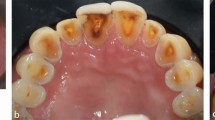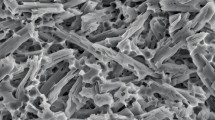Abstract
Traditional cold layering composite techniques can have limitations in the aesthetic rehabilitation of advanced tooth wear, with potentially high maintenance/failure rates and compromised aesthetics. This article explores advances in materials and clinical techniques involving monolithic ceramics and direct monolithic composites. These restorations satisfy the most aesthetically demanding patient, providing good to excellent aesthetics and long-term predictability.
Key points
-
Considers why traditional composite techniques can have high maintenance/failure rates and rapidly deteriorating aesthetics.
-
Describes current monolithic ceramics.
-
Describes the concept of heated-injection-moulded monolithic composites.
-
Outlines fundamental clinical protocols for success.
This is a preview of subscription content, access via your institution
Access options
Subscribe to this journal
Receive 24 print issues and online access
$259.00 per year
only $10.79 per issue
Buy this article
- Purchase on Springer Link
- Instant access to full article PDF
Prices may be subject to local taxes which are calculated during checkout




























Similar content being viewed by others
References
Loomans B, Opdam N, Attin T et al. Severe Tooth Wear: European Consensus Statement on Management Guidelines. J Adhes Dent 2017; 19: 111-119.
Ahmed K E, Murbay S. Survival rates of anterior composites in managing tooth wear: a systematic review. J Oral Rehabil 2016; 43: 145-153.
Bartlett D, Varma S. A retrospective audit of the outcome of composites to restore worn teeth. Br Dent J 2017; 223: 33-36.
Mehta S B, Lima V P, Bronkhorst E M et al. Clinical performance of direct composite resin restorations in a full mouth rehabilitation with severe tooth wear: 5.5-year results. J Dent 2021; 112: 103743.
Wazani B E, Dodd M N, Milosevic A. The signs and symptoms of tooth wear in a referred group of patients. Br Dent J 2012; DOI: 10.1038/sj.bdj.2012.840.
Condon M, Eaton K. An investigation into how general dental practitioners in Leeds manage complex tooth wear cases. Br Dent J 2020; 228: 366-370.
Tokiwa O, Park B-K, Takezawa Y, Takahashi Y, Sasaguari K, Sato S. Relationship of tooth grinding pattern during sleep bruxism and dental status. Cranio 2008; 26: 287-293.
Christensen G J. The major part of dentistry you may be neglecting. J Am Dent Assoc 2005; 136: 497-499.
Alfaifi A H. Restorative Management and Treatment of Pseudo-Class III Malocclusion. Case Rep Dent 2021; DOI: 10.1155/2021/8470222.
Smales R J, Berekally T L. Long-term survival of direct and indirect restorations placed for the treatment of advanced tooth wear. Eur J Prosthodont Restor Dent 2007; 15: 2-6.
Dalta S R, Alla R K, Alluri V R, Konaakanchi A. Dental Ceramics: Part II - Recent advances in dental ceramics. Am J Mater Engineer Technol 2015; 3: 19-26.
Kelly J R, Benetti P. Ceramic materials in dentistry: historical evolution and current practice. Aust Dent J 2011; 56: 84-96.
Höland W, Schweiger M, Frank M, Rheinberger V. A comparison of the microstructure and properties of the IPS Empress 2 and the IPS Empress glass ceramics. J Biomed Mater Res 2000; 53: 297-303.
Blatz M B, Vonderheide M, Conejo J. The Effect of Resin Bonding on Long-Term Success of High-Strength Ceramics. J Dent Res 2018; 97: 132-139.
Malament K A, Natto Z S, Thompson V, Rekow D, Eckert S, Weber H-P. Ten-year survival of pressed acid etched e.max disilicate monolithic and bilayered complete coverage restorations: Performance and outcomes as a function of tooth position and age. J Prosthet Dent 2019; 121: 782-790.
Edelhoff D, Güth J F, Erdelt K, Brix O, Liebermann A. Clinical performance of occlusal onlays made of lithum disilicate ceramic in patients with severe tooth wear up to 11 years. Dent Mater 2019; 35: 1319-1330.
Pieger S, Salman A, Bidra A S. Clinical outcomes of lithium disilicate single crowns and partial fixed dental prostheses: a systematic review. J Prosthet Dent 2014; 112: 22-30.
Garling A, Sasse M, Becker M E E, Kern M. Fifteen-year outcome of three-unit fixed dental prostheses made from monolithic disilicate ceramic. J Dent 2019; 89: 103178.
Becker M, Chaar M S, Garling A, Kern M. Fifteen-year outcome of posterior all-ceramic inlay-retained fixed dental prostheses. J Dent 2019; 89: 103174.
Zarone F, Ruggiero G, Leone R, Breschi L, Leuci S, Sorrentino R. Zirconia-reinforced lithium silicate (ZLS) mechanical and biological properties: A literature review. J Dent 2021; 109: 103661.
Ivoclar Vivadent. IPS e.max Clinical Guide. Available at https://issuu.com/ivoclarvivadent/docs/ips_emax_clinical_guide_de (accessed February 2023).
Cortellini D, Canale A. Bonding lithium disilicate ceramic to feather-edge tooth preparations: a minimally invasive treatment concept. J Adhes Dent 2012; 14: 7-10.
Denry I, Kelly J R. State of the art for zirconia for dental applications. Dent Mater 2008; 24: 299-307.
Hannink R H J, Kelly P M, Muddle B C. Transformation Toughening in Zirconia-Containing Ceramics. J Am Ceramic Soc 2000; 83: 461-487.
Schwarz S, Schröder C, Hassel A, Bömicke W, Rammelsberg P. Survival and chipping of zirconia-based and metal-ceramic implant-supported single crowns. Clin Implant Dent Relat Res 2012; DOI: 10.1111/j.1708-8208.2011.00388.x.
Larssson C, Vult von Steyern P. Five-year follow-up of implant-supported Y-TZP and ZTA fixed dental prostheses. A randomized, prospective clinical trial comparing two different materials systems. Int J Prosthodont 2010; 23: 555-561.
Moustapha G, Smaira E, Rahi M, Aad H A. How to Prevent Failure of Veneered Zirconia Ceramic. 2015. Available at https://www.dentalnews.com/2015/03/20/zirconia-ceramic-veneer-failure/ (accessed February 2023).
Sulaiman T A, Abdulmajeed A A, Donovan T E, Cooper L F, Walter R. Fracture rate of monolithic zirconia restorations up to 5 years: A dental laboratory survey. J Prosthet Dent 2016; 116: 436-439.
Denry I, Kelly R J. State of the art zirconia for dental applications. Dent Mater 2008; 24: 299-307.
Nagaoka N, Yoshihara K, Feitosa V P et al. Chemical interaction mechanism of 10-MDP with zirconia. Sci Rep 2017; 7: 45563.
Campos F, Valandro L F, Feitosa S A et al. Adhesive Cementation Promotes Higher Fatigue Resistance to Zirconia Crowns. Oper Dent 2017; 42: 215-224.
Sola-Ruiz M F, Bamia-Moscardo A, Selva-Otaolaaurruchi E et al. Wear In Anatagonisitc Teeth Produced by Monolithic Zirconia Crowns: A Systematic Review and Meta-Analysis. J Clin Med 2020; 9: 997.
Yin R, Lee M-H, Bae T-S, Song K-Y. Effect of finishing condition on the fracture strength of monolithic zirconia crowns. Dent Mater J 2019; 38: 203-210.
Hansen T J, Schriwer C, Øilo M, Gjengedal H. Monolithic zirconia crowns in the aesthetic zone in heavy grinders with severe tooth wear - An observational case-series. J Dent 2018; 72: 14-20.
Gulamali A B, Hemmings K W, Tredwin C J, Petrie A. Survival analysis of composite Dahl restorations provided to manage localised anterior tooth wear (ten year follow-up). Br Dent J 2011; DOI: 10.1038/sj.bdj.2011.683.
Manhart J, Mehl A, Schroeter R, Obster B, Hickel R. Bond strength of composite to dentine treated by air abrasion. J Oper Dent 1999; 24: 223-232.
Chaiyabutr Y, Kois J C. The effects of tooth preparation cleansing protocols on the bond strength of self-adhesive resin luting cement to contaminated dentine. Oper Dent 2008; 33: 556-563.
Tardem C, Albuquerue E G, Lopes L S et al. Clinical time and postoperative sensitivity after use of bulk-fill (syringe and capsule) vs. incremental filling composites: a randomised clinical trial. Braz Oral Res 2019; DOI: 10.1590/1807-3107bor-2019.vol33.0089.
Doronch M, Rueggeberg M, De Goes M F. Monomer conversion of pre-heated composite. J Dent Res 2005; 84: 663-667.
Opdam N, Roeters J J M, Joosten M, Veeke O V. Porosities and voids in Class I Restorations placed by six operators using a packable or syringable composite. Dent Mater 2022; 18: 58-63.
Cramer N B, Stansbury J W, Bowman C N. Recent advances and developments in composite dental restorative materials. J Dent Res 2011; 90: 402-416.
Da Costa J B, Hilton T J, Swift E J Jr. Critical appraisal: Preheating composites. J Esthet Restor Dent 2011; 23: 269-275.
Elkaffas A A, Eltoukhy R I, Elnegoly S A, Mahmoud S H. 36-Month Randomized Clinical Trial Evaluation of Preheated and Room Temperature Resin Composite. Oper Dent 2022; 47: 11-19.
Clark D. Composite resins and vertical dimension: treating severly worn lower incisors. Dent Today 2012; 31: 98-101.
Hassall D. Centric relation and increasing the occlusal vertical dimension: concepts and clinical techniques - part two. Br Dent J 2021; 230: 83-89.
Mullan S. Composite smile makeover. Clin Dent 2022; 2: 23-26.
Sivasithamparam K, Harbrow D, Vinczer E, Young W G. Endodontic sequelae of dental erosion. Aust Dent J 2003; 48: 97-101.
Nudel L, Pokhojaev A, Bitterman Y et al. Secondary Dentin Formation Mechanism: The Effect of Attrition. Int J Environ Res Public Health 2021; 18: 9961.
Lindskog-Sokland B, Hansen K, Tomasi C, Hakeberg M, Wennström J L. Changes in molar position associated with missing opposed and/or adjacent tooth: a 12-year study in women. J Oral Rehabil 2012; 39: 136-143.
Hassall D. Centric relation and increasing the occlusal vertical dimension: concepts and clinical techniques - part one. Br Dent J 2021; 230: 17-22.
Cardoso C A, Ferreira C F, Oderich E, Pedroso M L, Wicks R. Occlusal rehabilitation of pseudo-class III patient. J Prosthodont 2015; 24: 78-82.
Magne P. Immediate dentine sealing: A fundamental procedure for indirect bonded restoration. J Esthet Restor Dent 2005; 17: 144-155.
Johnson G H, Hazelton L R, Bales D J, Lepe X. The effect of a resin-based sealer on crown retention for three types of cement. J Prosthet Dent 2004; 91: 428-435.
Hassall D. Current concepts in aesthetic restorative dentistry. J Priv Dent 2018; 58-60.
Author information
Authors and Affiliations
Corresponding author
Ethics declarations
The author declares no conflicts of interest.
Rights and permissions
About this article
Cite this article
Hassall, D. The use of the monolithic ceramic and direct monolithic composite in the aesthetic rehabilitation of tooth wear. Br Dent J 234, 406–412 (2023). https://doi.org/10.1038/s41415-023-5621-3
Received:
Revised:
Accepted:
Published:
Issue Date:
DOI: https://doi.org/10.1038/s41415-023-5621-3
This article is cited by
-
Early failure of traditional composites in tooth wear
British Dental Journal (2024)
-
Losses loom larger than gains
British Dental Journal (2023)
-
Challenged by numerous studies
British Dental Journal (2023)
-
Somewhat misleading
British Dental Journal (2023)
-
Statistical manipulation and blobs
British Dental Journal (2023)



